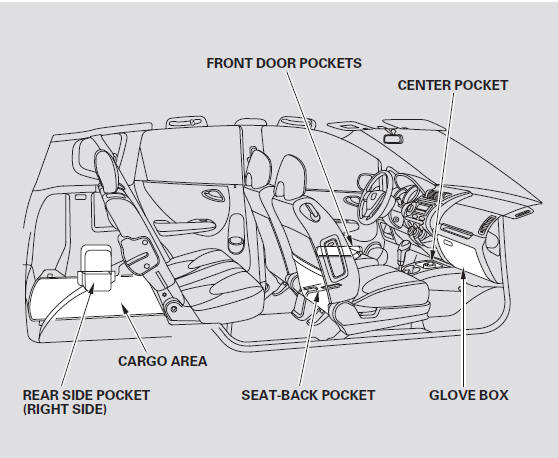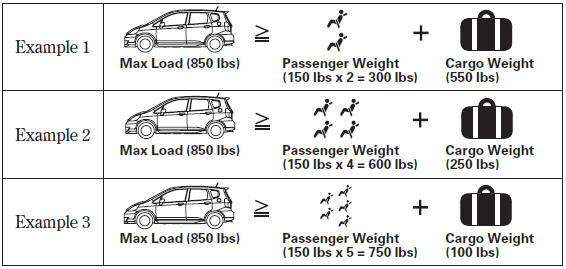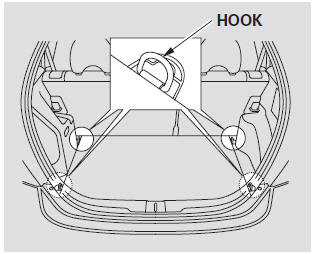Honda Fit: Carrying Cargo

Your vehicle has several convenient storage areas:
• Glove box
• Front door pockets
• Seat-back pocket
• Center pocket
• Cargo area side pocket
• Cargo area, including the rear seats when folded up or down.
However, carrying too much cargo, or improperly storing it, can affect your vehicle’s handling, stability, stopping distance, and tires, and make it unsafe. Before carrying any type of cargo, be sure to read the following pages.
Load Limits (Payload)
The maximum load for your vehicle is 850 lbs (385 kg) for U.S. vehicles, and 395 kg for Canadian vehicles.
See Tire And Loading Information label attached to the driver’s doorjamb.
Label Example

This figure includes the total weight of all occupants, cargo, and accessories, and the tongue load if you are towing a trailer.

Overloading or improper loading can affect handling and stability and cause a crash in which you can be hurt or killed.
Follow all load limits and other loading guidelines in this manual.
Steps for Determining Correct Load Limit - (1) Locate the statement ‘‘The combined weight of occupants and cargo should never exceed XXX kg or XXX lbs.’’ on your vehicle’s placard.
(2) Determine the combined weight of the driver and passengers that will be riding in your vehicle.
(3) Subtract the combined weight of the driver and passengers from XXX kg or XXX lbs.
(4) The resulting figure equals the available amount of cargo and luggage load capacity. For example, if the ‘‘XXX’’ amount equals 1,400 lbs. and there will be five 150 lb. passengers in your vehicle, the amount of available cargo and luggage load capacity is 650 lbs.
(1,400 750 (5 150) = 650 lbs.) (5) Determine the combined weight of luggage and cargo being loaded on the vehicle. That weight may not safely exceed the available cargo and luggage load capacity calculated in Step 4.
(6) If your vehicle will be towing a trailer, load from your trailer will be transferred to your vehicle.
Consult this manual to determine how this reduces the available cargo and luggage load capacity of your vehicle.

In addition, the total weight of the vehicle, all occupants, accessories, cargo, and trailer tongue load must not exceed the Gross Vehicle Weight Rating (GVWR) or the Gross Axle Weight Rating (GAWR). Both are on a label on the driver’s doorjamb.
Carrying Cargo in the Passenger Compartment
• Store or secure all items that could be thrown around and hurt someone during
a crash.
• Be sure items placed on the floor behind the front seats cannot roll underneath and interfere with the proper operation of the seats, the sensors under the seats, or the driver’s ability to operate the pedals.
• Keep the glove box closed while driving. If it is open, a passenger could injure their knees during a crash or sudden stop.
• f you fold the rear seats up or down, tie down items that could be thrown about the vehicle during a crash or sudden stop. Also, keep all cargo below the bottom of the windows. If it is higher, it could interfere with the proper operation of the side curtain airbags.
Carrying Cargo in the Cargo Area
• Distribute cargo evenly on the floor of the cargo area, placing the heaviest items on the bottom and as far forward as possible. Tie down items that could be thrown about the vehicle during a crash or sudden stop.
• Do not stack items higher than the back of the rear seats. They can block your view and be thrown around the vehicle during a crash.
• If you carry large items that prevent you from closing the tailgate, exhaust gas can enter the passenger area.
Optional Separation Net
The separation net can be used to hold back soft, lightweight items stored in the cargo area. Heavy items should be properly secured on the floor of the cargo area. The net may not prevent heavy items from being thrown forward in a crash or a sudden stop.

The four hooks on the floor can be used to install a net for securing items.
See also:
EVAP Canister Filter Replacement
Remove the air cleaner.
Disconnect the hoses (A).
Remove the EVAP canister filter (B).
Install the parts in the reverse order of removal.
...
Powertrain
...
Tire Pressure Monitoring System (TPMS) - Required Federal Explanation
Maximum Tire Pressure
Max Press - The maximum air pressure the tire can hold.
Maximum Tire Load
Max Load - The maximum load the tire can carry at maximum air pressure.
Tire PressureMonitoring Sys ...
